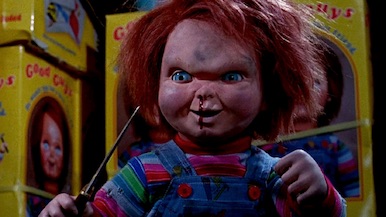Justice for Chucky
By Sean Collier
May 7, 2020
BoxOfficeProphets.com

The diminutive terror has never quite occupied the top tier of the iconic slasher stars. Jason Voorhees and Michael Myers have permanent seats on that council; Freddy Krueger is clinging to his spot, though he’s been out of mind for a good while. Pennywise the Clown has likely ascended to the popcorn-horror Mount Rushmore. Pinhead used to rank among the titans, but has spent too much time in the DVD bin.
Chucky, however, has always occupied the second tier, with the likes of the always-shifting Ghostface killer from the “Scream” series or flash-in-the-pan Jigsaw. A bit too silly, a bit too gimmicky. Each and every Halloween, you’ll find Jason’s mask and Freddy’s claws somewhere near the front door of your nearest pop-up costume store. If they have a Chucky outfit in stock, a clerk born at least a full decade after the release of “Child’s Play” will probably have to help you find it.
The injustice in this reveals itself to anyone hardy enough to watch the full “Child’s Play” series. I completed this quest recently — quarantine does funny things to your queue — and made a startling discovery.
The “Child’s Play” series is, on average, better than any of the iconic franchises mentioned above.
I admit that no singular entry in the Chucky lineup is quite the equal of a film like the original “Halloween” or “Nightmare on Elm Street.” Yet the average quality of a “Child’s Play” film is stronger than that of Chucky’s more merchandise-friendly counterparts. If you pick a random Chucky outing, in other words, you have a much better chance of enjoying it than you would if you selected an arbitrary “Friday the 13th.”
There have been eight “Child’s Play” films since the original appeared in November 1988. The first film is a witty, clever exemplar of ’80s horror — a solid concept buoyed by strong performances and then-advanced effects. The series has always had an effective premise; if you’re the one person insisting that a toy is sentient and murdering people, no one will believe you until they too are among the victims.
That premise was revived in an effective sequel, picking up immediately after the first film ended. A decade later, “Bride of Chucky” and “Seed of Chucky” were in a more comedic direction, serving as effective updates with heavy doses of metatextual playfulness; the latter film is also notable for the inclusion of a non-binary character, an unusual feature in 2004. (The portrayal is probably not up to current standards of sensitivity, but it was pretty solid for the early aughts.) Even the direct-to-video chapters, “Curse of Chucky” and “Cult of Chucky,” are surprisingly enjoyable single-set pieces using classic horror locales, as the reinvigorated doll — with continuing help from Jennifer Tilly, by this point playing multiple roles — terrorizes inside a sprawling manse and a mental-health facility.
Among all the films in the series, only the 2019 reboot is a significant letdown — and even it has a delicious performance by Mark Hamill, taking over as the voice of Chucky. (Okay, “Child’s Play 3” is a bit of a slog, but it has a fantastic ending.)
Compare that to the batting averages of the more storied franchises. Less than half of the “Friday the 13th” films could be called mediocre or better, and you could make the argument that none but the original are worth a casual viewer’s attention. Both “Nightmare on Elm Street” and “Halloween” had unwatchable entries; Chucky has never had a rampage as drab as “Nightmare on Elm Street 5: The Dream Child.”
Even Pennywise’s solid track record is buoyed by scarcity — and neither the back half of the “It” miniseries nor the modern “It Chapter Two” are particularly good.
None of this is to say that Chucky should be as widely watched as a terror-for-all movie such as “A Quiet Place” or even the 2018 “Halloween.” The series is more for horror fans and curious Halloween-season viewing; decidedly, “Child’s Play” is genre fare, not mainstream entertainment.
But within that context: Justice for Chucky. With pluck, one-liners and a working voodoo proficiency, the doll has turned what might’ve been a one-off slasher into a surprisingly resilient franchise. Horror aficionados who have not seen “Curse” or “Seed of Chucky” should dive in — and more casual viewers considering a popcorn exploration of Jason’s exploits should perhaps divert their attention to the Good Guy.
Just don’t try to figure out how he keeps coming back from burial, dismemberment, and further oblivion. Chucky has that in common with Jason and Michael Myers: A bizarre curse which resurrects him at precisely the moment a filmmaker thinks there’s money in it.